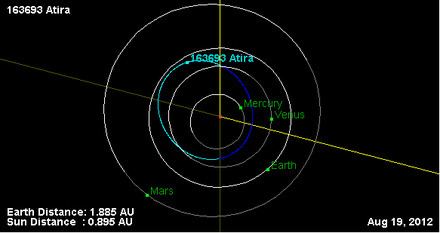Discovered by LINEAR Discovery date 11 February 2003 Alternative names 2003 CP20 Aphelion 98 cm Argument of perihelion 252.93° | Discovery site Lincoln Lab ETS MPC designation 163693 Atira Discovered 11 February 2003 Inclination 25.618° | |
 | ||
Similar (434326) 2004 JG6, Solar System, 2062 Aten, 3554 Amun, 3362 Khufu | ||
163693 Atira, provisional designation 2003 CP20, is an eccentric, stony asteroid, dwelling in the interior of Earth's orbit. It is classified as a near-Earth object and measures approximately 2 kilometers in diameter. Atira was discovered on 11 February 2003, by the Lincoln Near-Earth Asteroid Research (LINEAR) team at Lincoln Laboratory's Experimental Test Site in Socorro, New Mexico, United States.
It is the namesake and the first numbered body of the Atira asteroids, a new subclass of near-Earth asteroids, which have their orbits entirely within that of Earth and are therefore alternatively called Interior-Earth Objects (IEO). As of 2015, there are only 16 known members of the Atira group of asteroids. Atiras are similar to the larger group of Aten asteroids, as both are near-Earth objects and both have a semi-major axis smaller than that of Earth (< 1.0 AU). However, and contrary to Aten asteroids, the aphelion for Atiras is always smaller than Earth's perihelion (< 0.983 AU), which means that they do not approach Earth as close as Atens do in general. Atira has an Earth minimum orbit intersection distance of 0.2084 AU (31,200,000 km) or approximately 81.2 lunar distances.
Atira is a S-type asteroid and orbits the Sun at a distance of 0.5–1.0 AU once every 0 years and 8 months (233 days). Its orbit has an eccentricity of 0.32 and an inclination of 26° with respect to the ecliptic. With a perihelion of 0.50 AU the body also classifies as a Venus-crosser – as Venus orbits the Sun at a distance of 0.72–0.73 AU – but does not get as close to the Sun as Mercury (which orbits between 0.31 and 0.47 AU). As no precoveries were taken, Atira's observation arc begins with its discovery observation in 2003. It has a rotation period of 2.9745 hours with a brightness variation of 0.36 magnitude (U=n.a.) and an assumed albedo of 0.20.
Knowing that traditionally the first known object in a new class of asteroids will become the name of the new class of asteroids, due consideration was given to the name for (163693). The other classes of near-Earth asteroids are Amors, Apollos, and Atens (as mentioned above), named after a Roman, Greek, and Egyptian god, so a preference was given to a god or goddess beginning with the letter "A". Given (163693) was discovered by the LINEAR program which operates out of the southwestern United States, preference was also given to a name of local origin. The minor planet was named after Atira, a goddess of the Native American Pawnee people. She is the wife of the creator god, Tirawa, and goddess of Earth and the evening star. Naming citation was published on 22 January 2008 (M.P.C. 61768).
